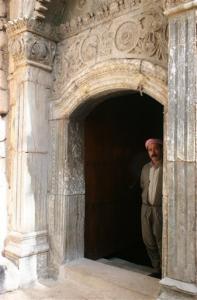
December 11, 2007 | By Paul Schemm, Associated Press Writer
LALESH, Iraq --Iraq's embattled Yazidi minority, the target of the worst single terrorist attack since the U.S.-led invasion, now is looking to the Kurdish regional government for protection.

In August, four suicide truck bombs detonated simultaneously in the small village of Qahataniya near the Iraqi border town of Sinjar, killing more than 500 Yazidis, a devastating blow to a community of no more than 500,000 people.
"While there have always been massacres and attacks, never has there been something as terrible as Sinjar," said Karim Suleiman, the head of the Yazidi cultural center in the town of Sheikhan, near Mosul. "We've never experienced something like this."
The Yazidis live along the sensitive faultline separating Kurds from Arabs -- a line whose location will be determined by a vote scheduled for April.
Article 140 of the Iraqi constitution states that there will be a referendum in the areas bordering the Kurdish autonomous region, including the northern oil city of Kirkuk, so that people can choose whether to be ruled by the central government or the Kurds.
The Yazidis are concentrated in key areas for the referendum, including lands coveted by the Kurds north of Mosul and around Sinjar on the Syrian border. The Kurds see the referendum as a chance to right Saddam Hussein's historic wrongs of forced population transfer and Arabization. The Arabs see it as a Kurdish land grab.
Over the centuries the Yazidis, who primarily speak Kurdish, have identified themselves as Arabs or Kurds, depending who held the upper hand. The community now has firmly thrown its lot in with the Kurdish regional government.
"We hope that the land now lived on by the Yazidis will join the Kurdish area," the community's leader, Amir Tahseen Beg, told the Associated Press from his residence in Sheikhan. "This will depend on the referendum, but our areas must return to the original motherland."
The Yazidis have always existed on the fringes of the region's history -- the occasional victim of pogroms when local leaders have accused them of devil worship. The community is widely viewed with suspicion and Yazidis have complained about discrimination, and even persecution, from both their Arab and Kurdish neighbors.
The Yazidis say that they are ethnic Kurds worshipping the original religion of their people before the advent of Islam, venerating in particular Malak Taus, the chief of the angels -- known in other religions as Lucifer -- who takes the form of a blue peacock.
With the creation of the Kurdish autonomous region in 1991 under the protection of U.S. forces, the Yazidi community was divided, with some 90 percent of its people remaining under Iraqi government control -- a government they say oppressed them, prevented them from practicing their religion and even declared them Arabs in 1977.
"Where the Kurds are, the Yazidis are and where the Yazidis are, the Kurds are -- we are one people and one nation," said Baba Sheikh Khurto Hajji Ismail, the community's religious leader. "The Yazids are from the old religion of the Kurds."
Yazidi religious practices have been described as a blend of Eastern religions with hints of the ancient pre-Christian Persian Zoroastrian and Mithraic practices, as well as elements of Christianity, Judaism and Islam.
All the monotheistic prophets are recognized, but Abraham and Noah are especially venerated.
The Yazidis' most important occasion is the Eid al-Jamma, or pilgrimage holiday, when the community scattered across Iraq, Turkey, Armenia, Georgia and Germany gathers in the temple city of Lalesh, nestled in a picturesque valley just north of Mosul.
In October 2006, the week-long festival was held for the first time in years due to improved security. Thousands of Yazidis, dressed in Kurdish, Arab, Turkish and European dress, walked barefoot among the conical temples of the sacred village, paid their respects and greeted rarely seen distant relatives.
The festival was canceled this year after the bombings in Sinjar.
"There are not many of us, so things like this really affect us," said Luqman Suleiman Mahmoud who was recently visiting the empty temple valley. "My people are like links in a chain, so any small thing affects us all," he said, adding that there have been few weddings or celebrations since the attack.
In the immediate aftermath of the bombings, Kurdish regional president Massoud Barzani dispatched a force of 400 Kurdish militia, known as peshmerga, to Sinjar to protect the Yazidis -- a provocative move considering his official jurisdiction does not extend to those lands.
"We did not get the approval of the central government because these forces have been sent for a short time and for humanitarian reasons," said Jabar Yawer, spokesman for the peshmerga.
The move was appreciated by Yazidi leader Tahseen Beg, and has reinforced the sense that the community's future must lie with the Kurdish autonomous region. He said his people just have one request from the government.
"We asking that the Yazidis be recognized," in the regional constitution being drawn up, which only has a clause granting equal rights to the different ethnicities in the region, including Kurds, Arabs, Turcoman, and Christian Assyrians, he said. "We are not just asking for respect for different ethnicities, but we would like a clause recognizing different religions within the ethnicity of the Kurds."


